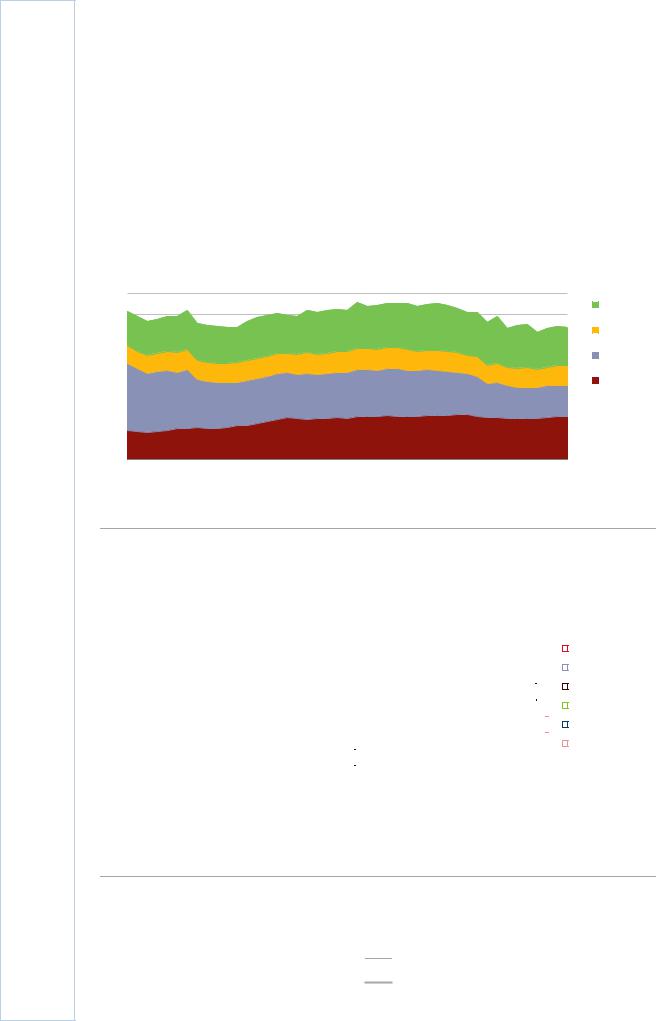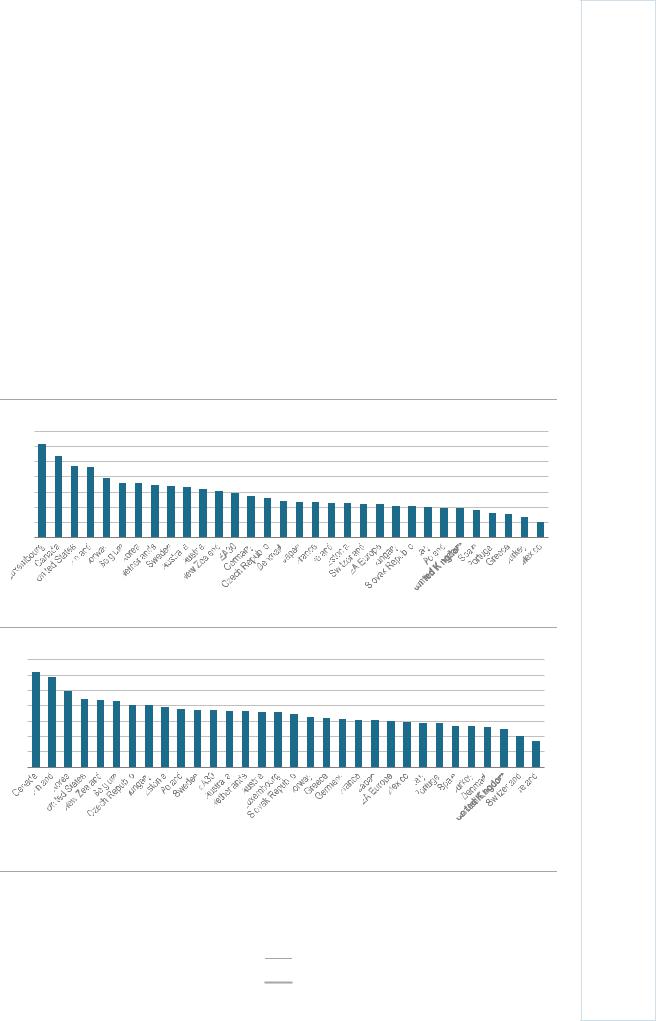
- •Foreword
- •Table of contents
- •Figures
- •Tables
- •Boxes
- •1. Executive summary
- •Energy system transformation
- •Special focus 1: The cost-effectiveness of climate measures
- •Special focus 2: The Electricity Market Reform
- •Special focus 3: Maintaining energy security
- •Key recommendations
- •2. General energy policy
- •Country overview
- •Institutions
- •Supply and demand trends
- •Primary energy supply
- •Energy production
- •Energy consumption
- •Energy policy framework
- •Energy and climate taxes and levies
- •Assessment
- •Recommendations
- •3. Energy and climate change
- •Overview
- •Emissions
- •GHG emissions
- •Projections
- •Institutions
- •Climate change mitigation
- •Emissions targets
- •Clean Growth Strategy
- •The EU Emissions Trading System
- •Low-carbon electricity support schemes
- •Climate Change Levy
- •Coal phase-out
- •Energy efficiency
- •Low-carbon technologies
- •Adaptation to climate change
- •Legal and institutional framework
- •Evaluation of impacts and risks
- •Response measures
- •Assessment
- •Recommendations
- •4. Renewable energy
- •Overview
- •Supply and demand
- •Renewable energy in the TPES
- •Electricity from renewable energy
- •Heat from renewable energy
- •Institutions
- •Policies and measures
- •Targets and objectives
- •Electricity from renewable energy sources
- •Heat from renewable energy
- •Renewable Heat Incentive
- •Renewable energy in transport
- •Assessment
- •Electricity
- •Transport
- •Heat
- •Recommendations
- •5. Energy efficiency
- •Overview
- •Total final energy consumption
- •Energy intensity
- •Overall energy efficiency progress
- •Institutional framework
- •Energy efficiency data and monitoring
- •Regulatory framework
- •Energy Efficiency Directive
- •Other EU directives
- •Energy consumption trends, efficiency, and policies
- •Residential and commercial
- •Buildings
- •Heat
- •Transport
- •Industry
- •Assessment
- •Appliances
- •Buildings and heat
- •Transport
- •Industry and business
- •Public sector
- •Recommendations
- •6. Nuclear
- •Overview
- •New nuclear construction and power market reform
- •UK membership in Euratom and Brexit
- •Waste management and decommissioning
- •Research and development
- •Assessment
- •Recommendations
- •7. Energy technology research, development and demonstration
- •Overview
- •Energy research and development strategy and priorities
- •Institutions
- •Funding on energy
- •Public spending
- •Energy RD&D programmes
- •Private funding and green finance
- •Monitoring and evaluation
- •International collaboration
- •International energy innovation funding
- •Assessment
- •Recommendations
- •8. Electricity
- •Overview
- •Supply and demand
- •Electricity supply and generation
- •Electricity imports
- •Electricity consumption
- •Institutional and regulatory framework
- •Wholesale market design
- •Network regulation
- •Towards a low-carbon electricity sector
- •Carbon price floor
- •Contracts for difference
- •Emissions performance standards
- •A power market for business and consumers
- •Electricity retail market performance
- •Smart grids and meters
- •Supplier switching
- •Consumer engagement and vulnerable consumers
- •Demand response (wholesale and retail)
- •Security of electricity supply
- •Legal framework and institutions
- •Network adequacy
- •Generation adequacy
- •The GB capacity market
- •Short-term electricity security
- •Emergency response reserves
- •Flexibility of the power system
- •Assessment
- •Wholesale electricity markets and decarbonisation
- •Retail electricity markets for consumers and business
- •The transition towards a smart and flexible power system
- •Recommendations
- •Overview
- •Supply and demand
- •Production, import, and export
- •Oil consumption
- •Retail market and prices
- •Infrastructure
- •Refining
- •Pipelines
- •Ports
- •Storage capacity
- •Oil security
- •Stockholding regime
- •Demand restraint
- •Assessment
- •Oil upstream
- •Oil downstream
- •Recommendations
- •10. Natural gas
- •Overview
- •Supply and demand
- •Domestic gas production
- •Natural gas imports and exports
- •Largest gas consumption in heat and power sector
- •Natural gas infrastructure
- •Cross-border connection and gas pipelines
- •Gas storage
- •Liquefied natural gas
- •Policy framework and markets
- •Gas regulation
- •Wholesale gas market
- •Retail gas market
- •Security of gas supply
- •Legal framework
- •Adequacy of gas supply and demand
- •Short-term security and emergency response
- •Supply-side measures
- •Demand-side measures
- •Gas quality
- •Recent supply disruptions
- •Interlinkages of the gas and electricity systems
- •Assessment
- •Recommendations
- •ANNEX A: Organisations visited
- •Review criteria
- •Review team and preparation of the report
- •Organisations visited
- •ANNEX B: Energy balances and key statistical data
- •Footnotes to energy balances and key statistical data
- •ANNEX C: International Energy Agency “Shared Goals”
- •ANNEX D: Glossary and list of abbreviations
- •Acronyms and abbreviations
- •Units of measure

5. Energy efficiency
Key data
(2017)
TFC: 127.3 Mtoe (oil 43.4%, natural gas 30.1%, electricity 20.3%, biofuels and waste 3.4%, coal 1.7%, heat 1.0%) -11% since 2007.
Consumption by sector: transport 32.6%, residential 29.0%, industry 23.8%, commercial 14.6%.
Energy consumption (TFC) per capita: 1.9 toe (IEA average: 2.9 toe), -17% since 2007.
Energy intensity (TFC/GDP PPP): 49.0 toe/USD million PPP (IEA average: 73.9), -20% since 2007.
Overview
Improving energy efficiency is central to meeting the United Kingdom’s long-term goal of cutting greenhouse gas (GHG) emissions by at least 80% from 1990 to 2050. In the past decade, the United Kingdom has managed to decouple its total final consumption (TFC) of energy from its economic growth and increasing population (Figure 5.1), thanks to energy efficiency improvements and structural changes in the economy.
Figure 5.1 Energy consumption and drivers, 1990-2017
Index 1990 |
|
|
|
|
|
|
|
|
|
1.8 |
|
|
|
|
|
|
|
|
GDP |
1.6 |
|
|
|
|
|
|
|
|
|
|
|
|
|
|
|
|
|
Population |
|
|
|
|
|
|
|
|
|
|
|
1.4 |
|
|
|
|
|
|
|
|
TFC |
|
|
|
|
|
|
|
|
|
|
1.2 |
|
|
|
|
|
|
|
|
TFC/capita |
|
|
|
|
|
|
|
|
|
|
1.0 |
|
|
|
|
|
|
|
|
TFC/GDP |
0.8 |
|
|
|
|
|
|
|
|
|
0.6 |
|
|
|
|
|
|
|
|
|
0.4 |
|
|
|
|
|
|
|
|
|
1990 |
1993 |
1996 |
1999 |
2002 |
2005 |
2008 |
2011 |
2014 |
2017 |
Despite a 72% increase in gross domestic product (GDP PPP) and 15% growth in population from 1990 to 2017, the TFC has declined by 8%, illustrating their decoupling.
Note: GDP data are in US dollars (USD) 2010 prices and Purchase Power Parity (PPP).
Source: IEA (2019), World Energy Balances 2019 First edition (database), www.iea.org/statistics/.
79
ENERGY SYSTEM TRANSFORMATION
IEA. All rights reserved.

5. ENERGY EFFICIENCY
Total final energy consumption
In 2017, the United Kingdom’s TFC was 127 million tonnes of oil equivalent (Mtoe), 11% lower than in 2007. The largest drop in TFC was in the industry sector, which fell by 22% between 2007 and 2017, whereas the residential sector decreased its consumption by 11% and the transport and commercial sectors remained relatively stable.
The transport sector is the largest energy-consuming sector (33% of the TFC in 2017), mainly road transport. The residential sector is the second largest (29%) with industry the third (24%), as illustrated in Figure 5.2.
Figure 5.2 TFC by sector, 1973-2017
Mtoe
160 |
|
|
|
|
|
|
|
|
|
|
Residential |
140 |
|
|
|
|
|
|
|
|
|
|
|
|
|
|
|
|
|
|
|
|
|
|
|
120 |
|
|
|
|
|
|
|
|
|
|
Commercial* |
|
|
|
|
|
|
|
|
|
|
|
|
100 |
|
|
|
|
|
|
|
|
|
|
Industry** |
80 |
|
|
|
|
|
|
|
|
|
|
Transport |
|
|
|
|
|
|
|
|
|
|
|
|
60 |
|
|
|
|
|
|
|
|
|
|
|
40 |
|
|
|
|
|
|
|
|
|
|
|
20 |
|
|
|
|
|
|
|
|
|
|
|
0 |
|
|
|
|
|
|
|
|
|
|
|
1973 |
1977 |
1981 |
1985 |
1989 |
1993 |
1997 |
2001 |
2005 |
2009 |
2013 |
2017 |
The transport sector is the largest energy consumer with 32% of the TFC and the total energy consumption slightly increased in recent years.
*Commercial includes commercial and public services, agriculture, and forestry. **Industry includes non-energy consumption.
Source: IEA (2019), World Energy Balances 2019 First edition (database), www.iea.org/statistics/.
Figure 5.3 TFC by source and sector, 2017
Industry* |
|
|
|
|
|
|
|
|
|
|
|
|
|
3% |
|
|
|
|
|
2% |
|
|
Oil |
|
|
|
|
|
|
|
|
|
|
|
|
|
|
|
|
|
|
|
|
|
|||||
|
|
|
36% |
|
|
|
27% |
|
|
5% |
|
|
26% |
|
|
|||||||||
|
|
|
|
|
|
|
|
|
|
Natural gas |
||||||||||||||
|
|
|
|
|
|
|
|
|
|
|
|
|
|
|
|
|
|
|
|
|
2%1% |
|
|
|
Transport |
|
|
|
|
|
|
|
|
|
|
|
|
|
|
|
|
|
|
|
|
|
|
Coal |
|
|
|
|
|
|
|
|
|
97% |
|
|
|
|
|
|
|
|
|
|
|
|
|
|||
|
|
|
|
|
|
|
|
|
|
|
|
|
|
|
|
|
|
|
|
|
||||
|
|
|
|
|
|
|
|
|
|
|
|
|
|
|
|
|
|
|
|
|
Bioenergy and waste |
|||
|
|
|
|
|
|
|
|
|
|
|
|
|
|
1% |
|
|
|
|
|
|
|
|
||
|
|
|
|
|
|
|
|
|
|
|
|
|
|
|
|
|
|
|
|
|
|
|||
Residential |
|
6% |
|
|
|
62% |
|
|
|
|
|
|
|
5% |
|
|
|
25% |
|
|
Electricity |
|||
|
|
|
|
|
|
|
|
|
|
|
|
|
|
|
|
|||||||||
|
|
|
|
|
|
|
|
|
|
|
|
|
|
|
|
|||||||||
Commercial** |
|
|
|
|
|
|
|
|
|
|
|
|
|
|
|
|
|
|
|
|
2% |
|
|
Heat |
|
|
|
|
|
|
|
|
|
|
|
|
|
|
|
|
|
|
|
|
|
|
|||
|
10% |
|
|
39% |
|
|
|
4% |
|
|
|
45% |
|
|
|
|
|
|
||||||
Total |
|
|
|
|
|
|
|
|
|
|
|
|
|
2% 3% |
|
1% |
|
|
|
|||||
|
|
|
43% |
|
|
|
|
|
30% |
|
|
|
|
|
|
|
|
20% |
|
|
|
|||
|
|
|
|
|
|
|
|
|
|
|
|
|
|
|
|
|
|
|
|
|
|
|
|
|
|
0% |
|
20% |
40% |
|
|
60% |
|
80% |
100% |
|
|
||||||||||||
Oil is the largest energy carrier overall and dominates in the transport sector, whereas natural gas and electricity account for considerable shares in all the other sectors.
*Industry includes non-energy consumption.
**Commercial includes commercial and public services, agriculture, and forestry.
Source: IEA (2019), World Energy Balances 2019 First edition (database), www.iea.org/statistics/.
80
IEA. All rights reserved.

5. ENERGY EFFICIENCY
Oil is the largest energy source in the United Kingdom’s final energy consumption, at 43% of TFC in 2016 (Figure 5.3). Most oil is consumed in transport, but it also has a large share in the industry sector. Natural gas is the second-largest source, at 30.8% of TFC. It accounts for the main part of residential energy consumption, and it has the second-largest shares in industry and commercial sectors. Electricity accounts for a considerable share in all the sectors except in transport and it is particularly important in the commercial sector. In recent years, biofuels have increased steadily in the residential and industry sectors.
Energy intensity
The United Kingdom has a relatively low energy intensity compared to other International Energy Agency (IEA) member countries, both by capita and by GDP (Figure 5.4). In 2017, the United Kingdom had the sixth-lowest TFC per capita, 18% below the IEA median. Furthermore, the United Kingdom had the third-lowest TFC per unit of GDP, 29% below the IEA median.
Figure 5.4 Energy intensity in IEA member countries, 2017
Energy consumption per capita (TFC/CAP)
7 toe/capita
6
5
4
3
2
1
0
Energy consumption per GDP (TFC/GDP)
140 toe/USD million PPP
120
100
80
60
40
20
0
In an IEA comparison, the United Kingdom has the sixth-lowest final energy consumption per capita and the third lowest consumption per GDP.
Notes: toe = tonnes of oil equivalent. Energy intensity in total final energy consumption, not including the energy transformation sector. GDP data are in USD billion 2010 prices and PPP.
Source: IEA (2019), World Energy Balances 2019 First edition (database), www.iea.org/statistics/.
81
ENERGY SYSTEM TRANSFORMATION
IEA. All rights reserved.
